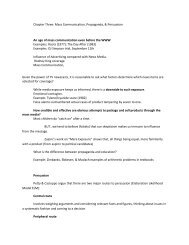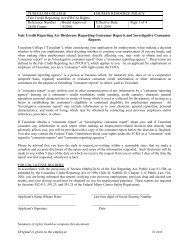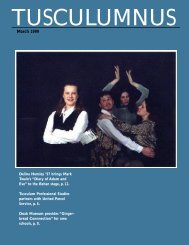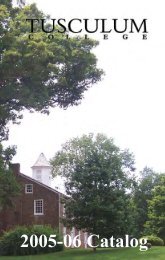- Page 2 and 3: TUSCULUM COLLEGE 2004-2005 Tusculum
- Page 4 and 5: TUSCULUM COLLEGE 2004-2005 TABLE OF
- Page 6 and 7: TUSCULUM COLLEGE 2004-2005 OUR MISS
- Page 8 and 9: TUSCULUM COLLEGE 2004-2005 The Anni
- Page 12 and 13: TUSCULUM COLLEGE 2004-2005 REGARDIN
- Page 14 and 15: TUSCULUM COLLEGE 2004-2005 aged by
- Page 16 and 17: TUITION AND FEES TUSCULUM COLLEGE 2
- Page 18 and 19: TUSCULUM COLLEGE 2004-2005 Graduati
- Page 20 and 21: TUSCULUM COLLEGE 2004-2005 For a Re
- Page 22 and 23: TUSCULUM COLLEGE 2004-2005 nancial
- Page 24 and 25: TUSCULUM COLLEGE 2004-2005 The new
- Page 26: TUSCULUM COLLEGE 2004-2005 THE TUSC
- Page 29 and 30: TUSCULUM COLLEGE 2004-2005 ADMISSIO
- Page 31 and 32: TUSCULUM COLLEGE 2004-2005 • Desc
- Page 33 and 34: TUSCULUM COLLEGE 2004-2005 STUDENT
- Page 35 and 36: TUSCULUM COLLEGE 2004-2005 • To e
- Page 37 and 38: TUSCULUM COLLEGE 2004-2005 intellec
- Page 39 and 40: TUSCULUM COLLEGE 2004-2005 tercolle
- Page 41 and 42: TUSCULUM COLLEGE 2004-2005 serve th
- Page 43 and 44: TUSCULUM COLLEGE 2004-2005 dent may
- Page 45 and 46: TUSCULUM COLLEGE 2004-2005 Withdraw
- Page 47 and 48: TUSCULUM COLLEGE 2004-2005 second o
- Page 49 and 50: TUSCULUM COLLEGE 2004-2005 process
- Page 51 and 52: TUSCULUM COLLEGE 2004-2005 Credit H
- Page 53 and 54: TUSCULUM COLLEGE 2004-2005 requirem
- Page 55 and 56: TUSCULUM COLLEGE 2004-2005 ing, or
- Page 57 and 58: TUSCULUM COLLEGE 2004-2005 Competen
- Page 59 and 60: TUSCULUM COLLEGE 2004-2005 students
- Page 61 and 62:
TUSCULUM COLLEGE 2004-2005 MATH 102
- Page 63 and 64:
TUSCULUM COLLEGE 2004-2005 Minicour
- Page 65 and 66:
TUSCULUM COLLEGE 2004-2005 Tusculum
- Page 67 and 68:
TUSCULUM COLLEGE 2004-2005 4.Comple
- Page 69 and 70:
TUSCULUM COLLEGE 2004-2005 ATEP stu
- Page 71 and 72:
TUSCULUM COLLEGE 2004-2005 The pers
- Page 73 and 74:
TUSCULUM COLLEGE 2004-2005 clinical
- Page 75 and 76:
TUSCULUM COLLEGE 2004-2005 within t
- Page 77 and 78:
TUSCULUM COLLEGE 2004-2005 ATEP 273
- Page 79 and 80:
TUSCULUM COLLEGE 2004-2005 PHED 115
- Page 81 and 82:
TUSCULUM COLLEGE 2004-2005 PHED 390
- Page 83 and 84:
TUSCULUM COLLEGE 2004-2005 BIOL 205
- Page 85 and 86:
TUSCULUM COLLEGE 2004-2005 BIOL 221
- Page 87 and 88:
TUSCULUM COLLEGE 2004-2005 BIOL 452
- Page 89 and 90:
TUSCULUM COLLEGE 2004-2005 The foll
- Page 91 and 92:
TUSCULUM COLLEGE 2004-2005 advertis
- Page 93 and 94:
TUSCULUM COLLEGE 2004-2005 BUSN 442
- Page 95 and 96:
TUSCULUM COLLEGE 2004-2005 will be
- Page 97 and 98:
TUSCULUM COLLEGE 2004-2005 program
- Page 99 and 100:
TUSCULUM COLLEGE 2004-2005 CISC 410
- Page 101 and 102:
TUSCULUM COLLEGE 2004-2005 tural ne
- Page 103 and 104:
TUSCULUM COLLEGE 2004-2005 When the
- Page 105 and 106:
TUSCULUM COLLEGE 2004-2005 meet the
- Page 107 and 108:
TUSCULUM COLLEGE 2004-2005 sibility
- Page 109 and 110:
TUSCULUM COLLEGE 2004-2005 SPED 450
- Page 111 and 112:
TUSCULUM COLLEGE 2004-2005 RELG 302
- Page 113 and 114:
TUSCULUM COLLEGE 2004-2005 consider
- Page 115 and 116:
TUSCULUM COLLEGE 2004-2005 EDUC 419
- Page 117 and 118:
TUSCULUM COLLEGE 2004-2005 ENGL 304
- Page 119 and 120:
TUSCULUM COLLEGE 2004-2005 Choose o
- Page 121 and 122:
TUSCULUM COLLEGE 2004-2005 ENGL 120
- Page 123 and 124:
TUSCULUM COLLEGE 2004-2005 ENGL 228
- Page 125 and 126:
TUSCULUM COLLEGE 2004-2005 will als
- Page 127 and 128:
TUSCULUM COLLEGE 2004-2005 ENVIRONM
- Page 129 and 130:
TUSCULUM COLLEGE 2004-2005 EVSC 302
- Page 131 and 132:
TUSCULUM COLLEGE 2004-2005 FIELD GU
- Page 133 and 134:
HISTORY TUSCULUM COLLEGE 2004-2005
- Page 135 and 136:
TUSCULUM COLLEGE 2004-2005 HIST 304
- Page 137 and 138:
TUSCULUM COLLEGE 2004-2005 tion and
- Page 139 and 140:
TUSCULUM COLLEGE 2004-2005 lonialis
- Page 141 and 142:
TUSCULUM COLLEGE 2004-2005 minates
- Page 143 and 144:
TUSCULUM COLLEGE 2004-2005 HGLN 341
- Page 145 and 146:
MASS MEDIA TUSCULUM COLLEGE 2004-20
- Page 147 and 148:
TUSCULUM COLLEGE 2004-2005 MASS 221
- Page 149 and 150:
TUSCULUM COLLEGE 2004-2005 gramming
- Page 151 and 152:
MATHEMATICS TUSCULUM COLLEGE 2004-2
- Page 153 and 154:
TUSCULUM COLLEGE 2004-2005 HIST 125
- Page 155 and 156:
TUSCULUM COLLEGE 2004-2005 MATH 204
- Page 157 and 158:
TUSCULUM COLLEGE 2004-2005 MEDICAL
- Page 159 and 160:
TUSCULUM COLLEGE 2004-2005 Students
- Page 161 and 162:
TUSCULUM COLLEGE 2004-2005 Social R
- Page 163 and 164:
TUSCULUM COLLEGE 2004-2005 MUSC 450
- Page 165 and 166:
TUSCULUM COLLEGE 2004-2005 PHYSICAL
- Page 167 and 168:
TUSCULUM COLLEGE 2004-2005 VII. OUT
- Page 169 and 170:
TUSCULUM COLLEGE 2004-2005 PHED 125
- Page 171 and 172:
TUSCULUM COLLEGE 2004-2005 Theory C
- Page 173 and 174:
TUSCULUM COLLEGE 2004-2005 PHED 161
- Page 175 and 176:
TUSCULUM COLLEGE 2004-2005 PHED 195
- Page 177 and 178:
TUSCULUM COLLEGE 2004-2005 cal educ
- Page 179 and 180:
TUSCULUM COLLEGE 2004-2005 PHED 370
- Page 181 and 182:
PHYSICS TUSCULUM COLLEGE 2004-2005
- Page 183 and 184:
TUSCULUM COLLEGE 2004-2005 Politica
- Page 185 and 186:
TUSCULUM COLLEGE 2004-2005 research
- Page 187 and 188:
TUSCULUM COLLEGE 2004-2005 PRE-PROF
- Page 189 and 190:
PRE-PHARMACY TUSCULUM COLLEGE 2004-
- Page 191 and 192:
TUSCULUM COLLEGE 2004-2005 Psycholo
- Page 193 and 194:
TUSCULUM COLLEGE 2004-2005 perceptu
- Page 195 and 196:
TUSCULUM COLLEGE 2004-2005 examined
- Page 197 and 198:
TUSCULUM COLLEGE 2004-2005 PSYC 415
- Page 199 and 200:
TUSCULUM COLLEGE 2004-2005 RELG 206
- Page 201 and 202:
SERVICE-LEARNING TUSCULUM COLLEGE 2
- Page 203 and 204:
TUSCULUM COLLEGE 2004-2005 SVLN 450
- Page 205 and 206:
SPANISH TUSCULUM COLLEGE 2004-2005
- Page 207 and 208:
TUSCULUM COLLEGE 2004-2005 Special
- Page 209 and 210:
TUSCULUM COLLEGE 2004-2005 HIST 125
- Page 211 and 212:
TUSCULUM COLLEGE 2004-2005 SPED 354
- Page 213 and 214:
TUSCULUM COLLEGE 2004-2005 will als
- Page 215 and 216:
THEATRE TUSCULUM COLLEGE 2004-2005
- Page 217 and 218:
TUSCULUM COLLEGE 2004-2005 College
- Page 219 and 220:
TUSCULUM COLLEGE 2004-2005 VISA 308
- Page 221 and 222:
TUSCULUM COLLEGE 2004-2005 A variet
- Page 223 and 224:
VISA 316. PRINTMAKING II. This is t
- Page 225 and 226:
TUSCULUM COLLEGE 2004-2005 for cred
- Page 227 and 228:
TUSCULUM COLLEGE 2004-2005 GRADUATE
- Page 229 and 230:
TUSCULUM COLLEGE 2004-2005 that eng
- Page 231 and 232:
TUSCULUM COLLEGE 2004-2005 (DSST),
- Page 233 and 234:
TUSCULUM COLLEGE 2004-2005 UNDERGRA
- Page 235 and 236:
TUSCULUM COLLEGE 2004-2005 sis, Mat
- Page 237 and 238:
TUSCULUM COLLEGE 2004-2005 appeal a
- Page 239 and 240:
TUSCULUM COLLEGE 2004-2005 Applican
- Page 241 and 242:
TUSCULUM COLLEGE 2004-2005 COURSES
- Page 243 and 244:
TUSCULUM COLLEGE 2004-2005 Social s
- Page 245 and 246:
TUSCULUM COLLEGE 2004-2005 Students
- Page 247 and 248:
TUSCULUM COLLEGE 2004-2005 in the o
- Page 249 and 250:
TUSCULUM COLLEGE 2004-2005 BUSN 342
- Page 251 and 252:
TUSCULUM COLLEGE 2004-2005 MASTER O
- Page 253 and 254:
TUSCULUM COLLEGE 2004-2005 program
- Page 255 and 256:
CURRICULUM TUSCULUM COLLEGE 2004-20
- Page 257 and 258:
TUSCULUM COLLEGE 2004-2005 vironmen
- Page 259 and 260:
TUSCULUM COLLEGE 2004-2005 physical
- Page 261 and 262:
CURRICULUM TUSCULUM COLLEGE 2004-20
- Page 263 and 264:
TUSCULUM COLLEGE 2004-2005 advances
- Page 265 and 266:
TUSCULUM COLLEGE 2004-2005 Students
- Page 267 and 268:
TUSCULUM COLLEGE 2004-2005 COVENANT
- Page 269 and 270:
TUSCULUM COLLEGE 2004-2005 tage as
- Page 271 and 272:
TUSCULUM COLLEGE 2004-2005 Church,
- Page 273 and 274:
TUSCULUM COLLEGE 2004-2005 Tusculum
- Page 275 and 276:
TUSCULUM COLLEGE 2004-2005 B. Holst
- Page 277 and 278:
TUSCULUM COLLEGE 2004-2005 develop
- Page 279 and 280:
TUSCULUM COLLEGE 2004-2005 of all s
- Page 281 and 282:
TUSCULUM COLLEGE 2004-2005 6. The P
- Page 283 and 284:
TUSCULUM COLLEGE 2004-2005 fessor i
- Page 285 and 286:
TUSCULUM COLLEGE 2004-2005 THE SMIT
- Page 287 and 288:
TUSCULUM COLLEGE 2004-2005 THE ANDR
- Page 289 and 290:
TUSCULUM COLLEGE 2004-2005 trustee
- Page 291 and 292:
TUSCULUM COLLEGE 2004-2005 RELIGIOU
- Page 293 and 294:
TUSCULUM COLLEGE 2004-2005 THE JUDI
- Page 295 and 296:
TUSCULUM COLLEGE 2004-2005 Marjorie
- Page 297 and 298:
TUSCULUM COLLEGE 2004-2005 THE JOHN
- Page 299 and 300:
TUSCULUM COLLEGE 2004-2005 purpose
- Page 301 and 302:
TUSCULUM COLLEGE 2004-2005 of Tuscu
- Page 303 and 304:
TUSCULUM COLLEGE 2004-2005 THE HARR
- Page 305 and 306:
TUSCULUM COLLEGE 2004-2005 THE DAVI
- Page 307 and 308:
TUSCULUM COLLEGE 2004-2005 THE W. G
- Page 309 and 310:
TUSCULUM COLLEGE 2004-2005 THE ROGE
- Page 311 and 312:
TUSCULUM COLLEGE 2004-2005 from Gre
- Page 313 and 314:
TUSCULUM COLLEGE 2004-2005 TRIO PRO
- Page 315 and 316:
LARRY R. ESTEPP ’91 President Fir
- Page 317 and 318:
FACULTY TUSCULUM COLLEGE 2004-2005
- Page 319 and 320:
TUSCULUM COLLEGE 2004-2005 M.B.A.
- Page 321 and 322:
TUSCULUM COLLEGE 2004-2005 FREEMAN,
- Page 323 and 324:
TUSCULUM COLLEGE 2004-2005 MCCALLIS
- Page 325 and 326:
TUSCULUM COLLEGE 2004-2005 ROBINETT
- Page 327 and 328:
TUSCULUM COLLEGE 2004-2005 VAN LARE
- Page 329 and 330:
TUSCULUM COLLEGE 2004-2005 Kathy Hi
- Page 331 and 332:
TUSCULUM COLLEGE 2004-2005 Douglas
- Page 333:
TUSCULUM COLLEGE 2004-2005 CALENDAR
















